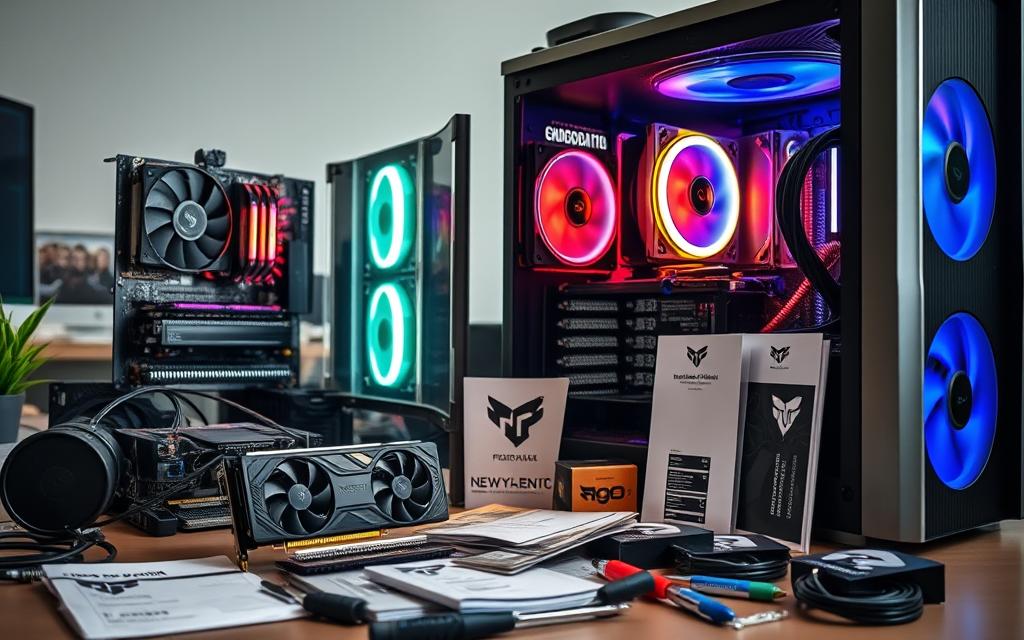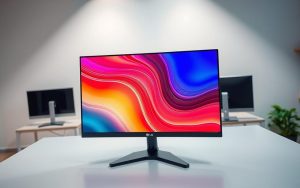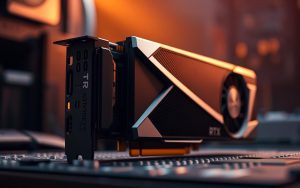Table of Contents
Keeping your system running smoothly matters for both work and play. Over time, even high-end setups slow down. Targeted improvements can breathe new life into your machine without breaking the bank.
Key components like RAM, storage, and GPU significantly impact speed. Gamers notice the difference first, but everyday tasks benefit too. Benchmarking tools help track progress, ensuring every dollar counts.
Most gaming rigs need tweaks every 2-4 years. Instead of buying new, strategic swaps save money. This guide covers essential upgrades to maximize your setup’s potential.
Why Upgrade Your PC?
Modern gaming and productivity software push hardware limits. Without periodic refreshes, even powerful rigs struggle with new demands. Strategic improvements keep your system competitive.
Signs Your PC Needs an Upgrade
Performance drops happen gradually. Watch for these red flags:
- Extended load times – Games or apps take noticeably longer to launch
- Visual artifacts – Screen tearing or texture glitches during gameplay
- Input lag – Delayed responses during critical gaming moments
- Overheating – Fans run constantly under normal workloads
Entry-level systems show these symptoms sooner. High-end builds typically last longer before needing attention.
How Long Does a Gaming PC Last?
Current gaming hardware follows predictable lifecycles:
| System Tier | Peak Performance Duration | Typical Upgrade Cycle |
|---|---|---|
| Budget Build | 1-2 years | Annual component swaps |
| Mid-Range | 2-3 years | Biannual refreshes |
| Premium | 3-5 years | Targeted GPU/CPU updates |
Recent data from Crucial shows game requirements outpace hardware capabilities by 18-24 months. This gap widens with each new console generation.
Memory and storage needs grow fastest. Today’s AAA titles often require 16GB RAM and SSD storage as minimum specs. Tomorrow’s releases will demand more.
How to Upgrade a PC: Essential Steps
Strategic hardware improvements follow a clear roadmap for best results. Begin by assessing your current setup’s bottlenecks. Benchmarking tools like UserBenchmark pinpoint weak spots in RAM, storage, or GPU performance.
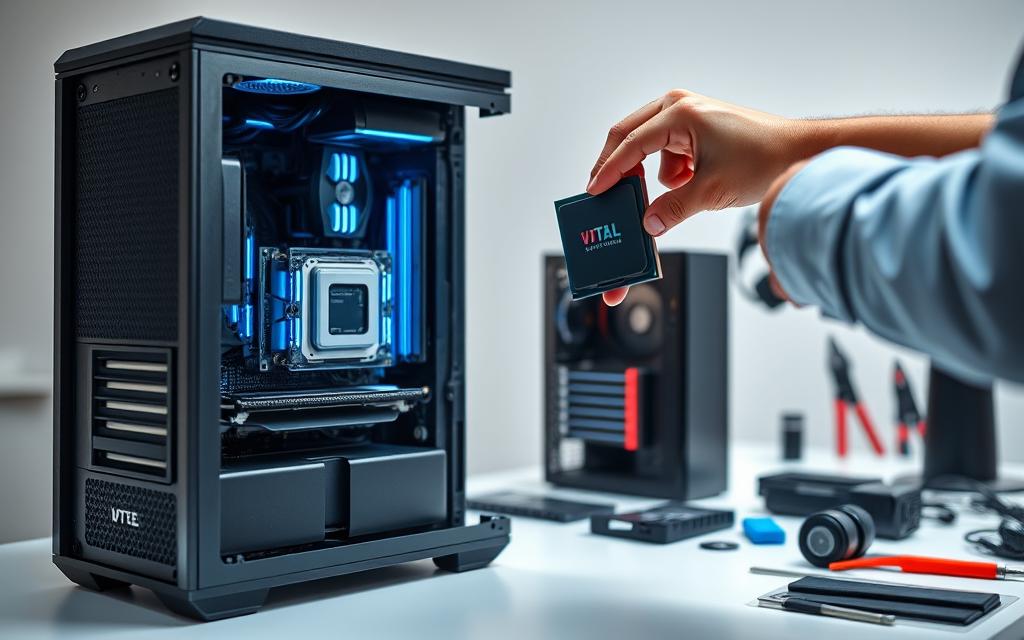
Prioritize components offering the highest return. Gamers often focus on GPUs first, while multitaskers benefit from RAM boosts. Use Crucial System Scanner to verify compatibility before purchases.
Allocate your budget wisely. SSDs deliver instant load-time improvements, while CPUs may require motherboard swaps. Balance cost against performance gains for maximum value.
- Tools matter: Anti-static wrist straps prevent electrical damage during installations.
- Driver updates: Always download the latest versions post-upgrade.
- Safety first: Power down and unplug the system before handling internals.
A methodical approach minimizes errors and ensures smooth transitions between old and new parts. Document each step to troubleshoot issues faster.
Boost Performance with More RAM
RAM upgrades deliver instant performance gains for demanding applications. Modern games load textures faster, while creative software handles larger files seamlessly. Higher capacity and speed reduce stuttering and improve responsiveness.
Choosing the Right RAM for Your System
DDR5 dominates new builds with speeds up to 8400 MT/s, doubling DDR4’s bandwidth. Crucial Pro DDR5 modules support overclocking out of the box. For older systems, DDR4 remains cost-effective but limits future-proofing.
Key considerations:
- Capacity: 16GB suits most gamers; 32GB excels for streaming or 4K editing.
- Latency: Lower CL numbers (e.g., CL16) mean quicker response times.
- Motherboard checks: Use Crucial System Scanner to avoid mismatches.
Dual-Channel vs. Single-Channel Memory
Dual-channel setups boost bandwidth by 15-20%. Install identical sticks in color-coded slots (e.g., slots 1+3). Single-channel mode wastes potential—always pair modules for optimal performance.
Pro tip: Quad-channel configurations exist but require high-end platforms. Most users benefit from dual-channel setups.
Upgrade Your Storage for Faster Load Times
Storage upgrades transform sluggish systems into responsive powerhouses. Modern games and applications demand rapid data access, making drive speed critical. Whether you’re battling load screens or editing 4K video, the right storage solution cuts waiting time by half.

SSD vs. HDD: Which Is Right for You?
SSDs outperform hard drives in every metric. Games load 5x faster, with NVMe models like the Samsung 990 PRO hitting 7,450 MB/s read speeds. HDDs still offer budget-friendly bulk storage but struggle with random read tasks.
- Random read/write: SSDs handle game textures at 70.6 MB/s vs. HDDs’ 1.6 MB/s.
- Endurance: Check TBW ratings—higher values mean longer SSD lifespan.
- Form factors: SATA SSDs suit older systems; NVMe drives need M.2 slots.
Migrating Data to a New Drive
Cloning preserves files but carries over clutter. Fresh installs optimize SSD performance but require reinstalling apps. For Steam libraries, use the backup feature or relocate folders manually.
“RAID 0 doubles speed by striping data across two drives—ideal for performance seekers with backups.”
Benchmarks show NVMe drives reduce game load times by 40% over SATA SSDs. Prioritize storage upgrades based on your workflow: gamers benefit from NVMe, while creatives may prefer high-capacity SATA SSDs.
Upgrade Your Graphics Card for Gaming
Modern games demand advanced GPUs to handle ray tracing and 4K resolutions. A graphics card upgrade delivers sharper visuals and higher frame rates. Entry-level models struggle with today’s AAA titles, making strategic swaps essential.

Choosing a Compatible GPU
Verify compatibility before purchasing. Newer cards like the RTX 4070 require PCIe 4.0 x16 slots. Check your motherboard’s specifications to avoid bottlenecks.
Key factors:
- VRAM: 8GB suits 1080p; 12GB+ excels at 4K gaming.
- Encoders: NVIDIA’s NVENC outperforms AMD for streaming.
- Case fit: Measure clearance—some GPUs exceed 330mm.
Power Supply Requirements for GPUs
High-end GPUs need robust power supplies. The RTX 4070 requires a 650W PSU minimum. Insufficient wattage causes crashes or throttling.
Connector types vary:
- Traditional 8-pin PCIe cables
- New 12VHPWR for RTX 40-series
“GPU sag brackets prevent long-term damage to PCIe slots.”
Balance performance with practicality. Mid-range cards often offer the best value for 1440p gaming. Always cross-check dimensions and power needs.
Improve Your Processor (CPU)
Your system’s brain determines how fast tasks complete. A processor upgrade unlocks smoother multitasking and better frame rates. Modern CPUs handle complex workloads that older models struggle with.
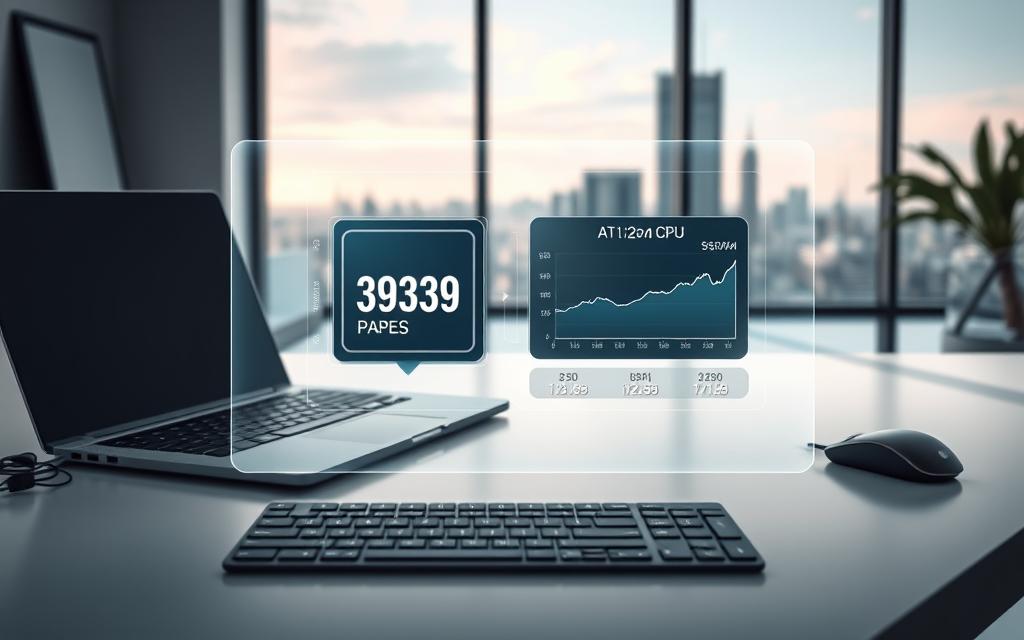
Core count and clock speed impact performance differently. More cores excel at video editing, while higher GHz benefits gaming. Use bottleneck calculators to identify imbalances between your GPU and CPU.
Matching CPUs with Motherboards
Compatibility matters when swapping processors. AMD’s AM5 and Intel’s LGA 1700 sockets require specific chipsets. Always check your motherboard specifications before purchasing.
| Socket Type | Current Gen CPUs | Cooler Compatibility |
|---|---|---|
| AM5 | Ryzen 7000 Series | Most AM4 coolers fit |
| LGA 1700 | 13th/14th Gen Intel | New bracket required |
BIOS updates often enable support for newer CPUs. Visit your motherboard manufacturer’s website for firmware files. Some boards need older processors installed to flash updates.
Cooling Solutions Compared
Thermal design power (TDP) ratings guide cooler selection. Air coolers like Noctua NH-D15 handle up to 250W efficiently. AIO liquid systems offer quieter, more compact alternatives for high-TDP chips.
- Air cooling: Reliable and cost-effective for most builds
- 240mm AIO: Ideal for overclocked mid-range CPUs
- 360mm AIO: Best for extreme processors like i9-14900K
Benchmark with Cinebench R23 to test thermal performance. CPU-Z provides detailed specs and real-time clock monitoring. Keep your system cool for sustained peak speeds.
Don’t Overlook Your Power Supply
Your components depend on clean, consistent power to perform. A weak power supply causes crashes, throttling, or permanent damage. Quality units protect investments in GPUs and CPUs.
80 Plus certification ensures energy efficiency. Bronze units deliver 82% efficiency, while Titanium models reach 94%. Higher ratings mean less wasted electricity and cooler operation.
Modular designs reduce cable clutter. Fully modular PSUs let you connect only needed cables. Semi-modular versions have fixed motherboard and CPU connectors.
Multi-GPU setups need robust rail configurations. Single-rail designs simplify installation, while multi-rail options enhance safety. High-end systems often require 1000W+ units with PCIe 5.0 connectors.
Capacitors degrade over time. Quality Japanese capacitors last 7-10 years versus 3-5 for budget alternatives. Replace aging units before they fail unexpectedly.
“Never daisy-chain PCIe power cables—use separate leads for each connector.”
ATX 3.0 standards handle power spikes better. New 12VHPWR connectors support next-gen hardware. Always verify wattage requirements using online calculators before purchasing.
Enhance Your Gaming Experience with Peripherals
Peripheral upgrades transform gameplay precision and immersion. While GPUs and CPUs drive performance, accessories like mice, monitors, and audio gear refine every interaction. Competitive players rely on these tools for split-second advantages.
Gaming Mice and Keyboards
Polling rates dictate responsiveness. A 1000Hz mouse reports positions every 1ms—ideal for esports. Higher rates (4000Hz+) offer diminishing returns and strain systems.
Switch types alter tactile feedback:
- Mechanical: Tactile bumps, 20-100M keystroke lifespan
- Optical: Faster actuation, 50-100M keystroke durability
Monitors: Resolution and Refresh Rates
144Hz vs. 240Hz impacts motion clarity. Variable refresh rate (VRR) tech like G-Sync eliminates tearing by syncing frames to the GPU’s output.
HDR certifications ensure visual fidelity:
- DisplayHDR 400: 400 nits brightness
- DisplayHDR 1000: 1000 nits with local dimming
Sound Cards and Audio Quality
High-impedance headphones (>100Ω) need DAC/AMP combos for clean power. THX Spatial Audio creates 3D soundscapes for positional awareness.
“Dedicated sound cards reduce CPU load versus onboard audio.”
Optimize Your Software and Drivers
Fine-tuning your system’s software unlocks hidden performance potential. Outdated drivers or background programs can throttle even high-end hardware. Focused adjustments ensure smoother gameplay and faster workflows.
Clean driver installations prevent conflicts. Use DDU (Display Driver Uninstaller) to remove old GPU drivers completely. Fresh installs fix glitches and boost stability.
Essential optimization tools:
- MSI Afterburner: Adjust GPU voltage curves for better cooling and performance.
- Razer Cortex: Frees up RAM by closing unnecessary background processes.
- CCleaner: Clears temporary files that slow down storage drives.
Windows Game Mode prioritizes resources for games, but may hinder multitasking. Disable it when streaming or running creative software.
BIOS tuning maximizes hardware potential:
- Enable AMD EXPO or Intel XMP for faster RAM speeds.
- Update firmware to support newer CPUs and security patches.
“Malware scans should run weekly—infected systems lose up to 30% performance.”
Regular driver updates patch vulnerabilities and improve compatibility. Roll back problematic versions via Device Manager if new releases cause crashes.
Benchmarking Your PC for Upgrades
Benchmarking tools provide concrete data for smarter hardware upgrades. Accurate tests reveal which components limit your system’s performance, ensuring you invest in the right improvements.
Synthetic benchmarks stress-test components under controlled conditions. Tools like 3DMark simulate extreme workloads, ideal for comparing peak speed. Real-world tests (e.g., game framerates) reflect daily usage more accurately.
UserBenchmark’s 4-component test evaluates CPU, GPU, RAM, and storage. Results show percentile rankings—aim for the 99th percentile in critical areas. Discrepancies highlight upgrade priorities.
“Margin of error averages 3–5%—focus on consistent patterns, not single outliers.”
Popular testing tools for specific components:
- CrystalDiskMark: Measures storage read/write speeds
- Cinebench R23: CPU multi-core performance
- Unigine Heaven: GPU stability under load
Custom PC Builder tools integrate benchmark data to suggest compatible upgrades. Cross-reference results with your budget to maximize value.
Conclusion
Strategic upgrades elevate your system’s gaming performance without overspending. Focus on components like RAM and SSDs first—they deliver noticeable improvements at lower costs.
Trusted brands like Crucial and Corsair ensure reliability. Their products balance quality with affordability, making them ideal for incremental enhancements.
Regular maintenance preserves hardware longevity. Clean internals quarterly and update drivers monthly for peak efficiency.
Balance aspirations with budget constraints. Prioritize high-impact swaps, then expand over time. For real-world examples, explore this upgrade journey showcasing smart component choices.
This guide equips you to enhance your experience methodically. Start small, track progress, and enjoy smoother performance at every step.
FAQ
What are the key signs my PC needs an upgrade?
Slow boot times, lagging performance in games or programs, frequent crashes, and insufficient storage are common indicators. Upgrading components like RAM, storage, or the GPU can resolve these issues.
How often should I upgrade my gaming PC?
Gaming systems typically last 3-5 years before needing major hardware upgrades. However, incremental improvements like adding more RAM or switching to an SSD can extend usability.
Is upgrading RAM or storage better for performance?
Both matter. More RAM improves multitasking, while an SSD speeds up load times. For optimal results, consider upgrading both if your budget allows.
How do I know if a new GPU is compatible with my system?
Check your motherboard’s PCIe slots, power supply wattage, and physical case space. NVIDIA and AMD provide compatibility tools for their graphics cards.
Do I need to upgrade my power supply when adding a new GPU?
High-end GPUs often require stronger power supplies. Verify the GPU’s power requirements and ensure your PSU has sufficient wattage and the right connectors.
Can I upgrade my CPU without changing the motherboard?
Only if the new processor uses the same socket type as your current motherboard. Check manufacturer specifications for compatibility before purchasing.
What’s the biggest performance boost for gaming?
A faster GPU and SSD provide the most noticeable improvements. High-refresh-rate monitors also enhance the gaming experience.
Should I upgrade my hard drive to an SSD?
Yes. SSDs offer significantly faster boot times, quicker file transfers, and smoother performance in games and applications compared to traditional HDDs.
How do I transfer data from my old drive to a new SSD?
Use cloning software like Macrium Reflect or Samsung Data Migration. Alternatively, reinstall your OS and manually transfer files for a clean setup.
Are driver updates necessary after hardware upgrades?
Absolutely. Updated drivers ensure optimal performance and stability. Always download the latest versions from the manufacturer’s website.


